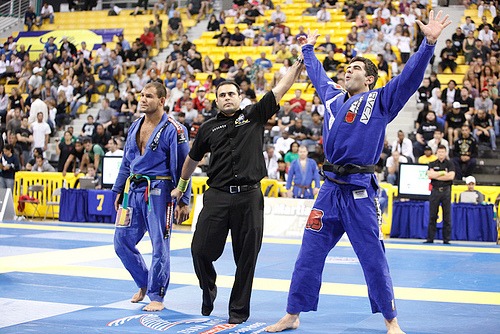
I’ve mentioned the clear progression of the technical focus in every belt in BJJ before. Still, I’ll take this opportunity to go over them all again. At white belt, you’re the walking dead, trying to scrape anything you can in order to justify coming back. As a blue belt, you become the master of defense, before you finally open up and start experimenting like crazy at purple belt. Brown is the time of reflection when you start looking back at fundamentals, this time around actually understanding them. Finally, at a black belt, you get to pull off stuff that seems impossible to pull off. However, at every belt level, for every grappler alive, the same rules apply – You need to understand the Brazilian Jiu-Jitsu basics.
The thing with Brasilian Jiu-Jitsu basics is that most people misunderstand them. The fundamental techniques of Jiu-Jitsu and Brazilian Jiu-Jitsu basics are not the same things. Fundamentals refer to moves that make up most of Jiu-Jitsu like submissions, sweeps, or guard passes. Basics refer to how things work and understanding why everything that is happening is happening during rolling. If you manage to get that down. you’ll be able to win every match, and even every roll, if there is such a thing.
Brazilian Jiu-Jitsu Basics For The Win
Most of the black belts out there often preach the importance of fundamentals and Brazilian Jiu-Jitsu basics. In contrast, most other belts, listen and nod and then go do their own thing over and over again. I guess this is how the natural progression of BJJ goes. Still, if you actually take the time to listen, you’ll see that Brazilian Jiu-Jitsu basic can actually help you win at everything, form matches to your progress throughout the art. Moreover, focusing on basics can significantly shorten the time you spent at every belt, meaning you’ll be one of those that get to the black belt in a very short time.
Let’s look at some examples of Brazilian Jiu-Jitsu basics. Once again, I’ll try to throw in fundamentals into each example, just so you can see the difference between the two. For starters, Roger Gracie’s success with the cross-collar choke. The choke itself, as a technique is fundamental. However, Roger’s approach to it, from the mount position as the launchpad to the way he thinks about it is Brazilian Jiu-Jitsu basics. Why? Because he understands how the choke works, meaning there’ no defense, or body type that can stand up to it.
The choke is a very precise example of the basics at the highest possible levels of the game. In rolling, and in other belt levels, we need a broader understanding of BJJ basics. For example, understanding what a guard is, and how to get past it. Knowing that you can’t actually pass a guard, but rather the legs is what will get you past any guard. Moreover, knowing that the free leg in an open guard is the one you need to beat, means you already have an upper hand. Once a guard is broken, you can freely pass using any fundamental, from the Torreando to the knee slice. There are countless examples of this in every aspect of Jiu-Jitsu.
The Four Rules Of Competition
When it comes to competition, things are extremely simple. Yet, if you look at people competing, you’ll see everyone complicating things much more than they need. Of course, you’re free to experiment and try out fancy stuff, but if you’re in it for the win. You need to follow a few simple Brazilian Jiu-Jitsu basics. Four of them, to be precise. And, before I go on, I have to credit Chris Haueter with these steps, because that’s who I learned them from.
Rule #1
The first rule is one that people that come for a wrestling or Judo background have installed in them – be on top. It means always aiming to be the grappler on top in every exchange. Why? The answer is simple – points. Name one bottom position that will give you points in a BJJ match. No? That’s because there isn’t one. All the positions that bring points are top positions. Moreover, it is much easier to stay in top positions for longer, as opposed to fighting off the bottom. But there’s more. There’s also a big rules-related hack regarding the top position, but I’ll talk about that one in the second rule.
Rule #2
Stay on top. It couldn’t be more straightforward than this. Once you’re the one that has the top position, never ever relinquish it. Staying on top means the opponent has to battle both against your position and your attacks. Plus, that points hack I mentioned. When you get to mount or back mount, you do not have to worry about inactivity. Since you’re already at the top of the mountain, you can’t receive penalties for stalling. It is the bottom person’s job to get out, so you can just ride it out, enjoying a massive points advantage. Brazilian Jiu-Jitsu basics 101.
Rule #3
This is where we switch gears. This rule is about playing guard and it says “You Shall Not Pass”! Let’s be honest, at a certain point in time, you’ll be in a guard position in Jiu-Jitsu. And that’s perfectly ok. What you need to make sure is that you choose a guard, any guard, that you are very confident of. It should be the one guard that your opponents have immense difficulty in passing. The goal here is to keep them at bay until such time that you can reclaim top position, or get a submission. However, the single most important thing here is not to let anyone past your legs.
Rule #4
Finally the simplest rule of them all, but perhaps the most important one. Especially in the case of blue/purple belt competitors. the last rule here is to remember rule number 1. Why? Because playing guard is fun. There are so many guards you can easily get lost. Granted it is very cool to transition from half guard to butterfly guard, to X guard and inverted de la spider worm guard. However, that doesn’t mean you’re effectively fighting, which is the main point in a BJJ match. So, when you’re playing guard, always play it with the intention of not letting people pass, and returning to the top as soon as possible.
Three Rules For Rolling
Now that you’re a machine at competition let’s see how you can actually build on your game and improve by utilizing Brazilian Jiu-Jitsu basics. When it comes to rolling, there’s no way to actually win. However, you can manage to achieve personal milestones and projects if you know what you’re doing. Even more importantly, if you know what the other person is doing. To that extent, there are there main things that will pretty much guarantee you end up in a favorable position, even if you find yourself in a mad scramble. Big thanks to Christian Graugart for pointing the following Brazilian Jiu-Jitsu basics out.
-
Inside position
If yоu’ve seen any Danaher DVD or Youtube clip for that matter, you’ve heard this one over and over again. Well, newsflash – inside position is not just a leg lock ting. In fact, it is a concept that has been a huge part of BJJ for a long time. Think about the butterfly guard – that’s inside position on the legs. Now think about holding someone in a closed guard with a collar and sleeve grip – that’s inside position on the torso.
I could go on and on. The basic idea here is that you always want to get your limbs to the inside of the partners’ limbs. That’s it. In terms of the upper body, that means controlling the shoulders or any part of the torso with your arms or legs. In terms of the lower body, it means having inside hooks anywhere along the legs (butterfly guard, X guard, etc.). This one is huge and will do wonders for your defensive positioning and counterattacking.
-
Spine Alignment (Posture)
The reason I say spinal alignment is because it will be easier to explain. Posture is a simple concept, yet people seem to forget about it all the time. Posture doesn’t just work forward and backward. It also works sideways, as well as in a twisting motion. To that extent, you always want to have a solid posture of your own and break your partner’s posture.
Achieving the first is simple – make sure your butt and your head are constantly in the same line. That’s about it. Whether you’re in a seated guard or doing an over-under pass, adhere to this rule, and there’;’s nothing that can stop you in your tracks. In terms of braking posture, do the opposite – try and get your partner’s head and but out of alignment. That’s when you can pass, sweep, submit, transition, or do whatever it is you’re doing.
-
Open Elbow
Finally, you have the open elbow, something quite popularized by Ryan Hall. Once again, the idea is simple – place your partner’s elbow as far away from their body as possible, and that arm will be defenseless. In fact, if the elbow is at shoulder height you’re doing great. However, if you manage to get it above shoulder height, you can pretty much do anything you want your partner. Now pair this up with the two previous examples of Brazilian Jiu-Jitsu basics and you’ll deal with everything your partners throw at you.
Use these three and you’ll understand everything that’s happening in every roll, even if your partner is playing things you’ve never seen before. These are universal and they work against everyone. It might take some time for you to start recognizing them, but once you do, Jiu-JItsu is going to become simple. And that’s when you really start enjoying BJJ.
Wrapping Up
The Brazilian Jiu-Jitsu basics I shared with you today are universally effective. They’re also very easy to understand and apply. The key is, once again in simplicity. Be on top, stay on top, have an unpassable guard, and don’t’ get stuck on the bottom and you’ll be a nuisance for anyone in tournaments. When you’re rolling, focus on opening the elbows, having spinal alignment, and conquering inside position and there’s nothing anyone can do to surprise you. Plus, in both cases, everything you want to do is going to be extremely easy to pull off. Now go and have fun!


![Darce Choke Encyclopedia – Origins, Mechanics and Variations [2025] BJJ, choke, Brabo, BJJ Darce Choke, D'arce Choke, Darce BJJ Choke](https://bjj-world.com/wp-content/uploads/2017/11/JungPoirierLeeYahoo-218x150.jpg)









![Get Off My Legs Gringo Craig Jones DVD Review [2025] Get Off My Legs Gringo Craig Jones DVD Review](https://bjj-world.com/wp-content/uploads/2025/03/get-off-my-legs-gringo-craig-jones-dvd-review-218x150.png)

![Leg Lock Entries Helena Crevar DVD Review [2025] Leg Lock Entries Helena Crevar DVD Review](https://bjj-world.com/wp-content/uploads/2025/03/leg-lock-entries-helena-crevar-dvd-review-218x150.png)
![Special K Guard Neil Melanson DVD Review [2025] Special K Guard Neil Melanson DVD Review](https://bjj-world.com/wp-content/uploads/2025/03/special-k-guard-neil-melanson-dvd-review-218x150.png)
![Arm Bar It All Shawn Melanson DVD Review [2025] Arm Bar It All Shawn Melanson DVD Review](https://bjj-world.com/wp-content/uploads/2025/03/arm-bar-it-all-shawn-melanson-dvd-review-218x150.png)


![Top Half Guard Neil Melanson DVD Review [2025] Top Half Guard Neil Melanson DVD Review](https://bjj-world.com/wp-content/uploads/2025/02/top-half-guard-neil-melanson-dvd-review-100x70.png)


![Wrestling For Jiu-Jitsu Shawn Williams DVD Review [2025] Wrestling For Jiu-Jitsu Shawn Williams DVD Review](https://bjj-world.com/wp-content/uploads/2025/01/wrestling-for-jiu-jitsu-shawn-williams-dvd-review-100x70.png)
![Ginastica Natural Alvaro Romano DVD Review [2024] Ginastica Natural Alvaro Romano DVD Review](https://bjj-world.com/wp-content/uploads/2024/12/ginastica-natural-alvaro-romano-dvd-review-100x70.png)

![Intro To Hip Mobility for Guard Players Joshua Presley DVD Review [2024] Intro To Hip Mobility for Guard Players Joshua Presley DVD Review](https://bjj-world.com/wp-content/uploads/2024/09/hip-mobility-for-guard-joshua-presley-dvd-review-100x70.png)



![Back Control and Submission Felipe Pena DVD Reveiw [2025] Back Control and Submission Felipe Pena DVD Reveiw](https://bjj-world.com/wp-content/uploads/2025/01/back-control-and-submission-felipe-pena-dvd-reveiw-100x70.png)
![10th Planet Leg Locks Jeremiah Vance DVD Review [2025] 10th Planet Leg Locks Jeremiah Vance DVD Review](https://bjj-world.com/wp-content/uploads/2025/01/10th-planet-leg-locks-jeremiah-vance-dvd-review-100x70.png)

![Finish on the Back Ethan Crelinsten DVD Review [2024] Finish on the Back Ethan Crelinsten DVD Review](https://bjj-world.com/wp-content/uploads/2024/10/finish-on-the-back-ethan-crelinsten-dvd-review-100x70.png)
![Just Pass Jay Rodriguez DVD Review [2024] Just Pass Jay Rodriguez DVD Review](https://bjj-world.com/wp-content/uploads/2024/11/just-pass-jay-rodriguez-dvd-review-100x70.png)
![Advanced Chin Control Concepts David Petrone DVD Review [2025] Advanced Chin Control Concepts David Petrone DVD Review](https://bjj-world.com/wp-content/uploads/2025/01/chin-control-concepts-david-petrone-dvd-review-100x70.png)
![Dynamic Headquarters Passing Jason Rau DVD Review [2024] Dynamic Headquarters Passing Jason Rau DVD Review](https://bjj-world.com/wp-content/uploads/2024/10/dynamic-headquarters-passing-jason-rau-dvd-review-100x70.png)
![Forging The De La Riva Guard Giancarlo Bodoni DVD Review [2025]](https://bjj-world.com/wp-content/uploads/2025/02/de-la-riva-guard-giancarlo-bodoni-dvd-review-100x70.png)
![Compass Kneebar System Charles Harriott DVD Review [2024] Compass Kneebar System Charles Harriott DVD Review](https://bjj-world.com/wp-content/uploads/2024/11/compass-kneebar-system-charles-harriott-dvd-review-100x70.png)
![Power Passing Body Locks Dan Manasoiu DVD Review [2025] Power Passing Body Locks Dan Manasoiu DVD Review](https://bjj-world.com/wp-content/uploads/2025/01/power-passing-body-locks-dan-manasoiu-dvd-review-100x70.png)

![How To Knee Cut Junny Ocasio BJJ DVD Review [2025] How To Knee Cut Junny Ocasio BJJ DVD Review](https://bjj-world.com/wp-content/uploads/2025/02/how-to-knee-cut-junny-ocasio-bjj-dvd-review-100x70.png)

![BJJ Foundations Mikey Musumeci DVD Bundle Review [2024] BJJ Foundations Mikey Musumeci DVD Bundle Review](https://bjj-world.com/wp-content/uploads/2024/09/bjj-foundations-mikey-musumeci-dvd-bundle-review-100x70.png)
![Closed Guard Reintroduced Adam Wardzinski DVD Review [2025] Closed Guard Reintroduced Adam Wardzinski DVD Review](https://bjj-world.com/wp-content/uploads/2025/01/closed-guard-reintroduced-adam-wardzinski-dvd-review-100x70.png)

![Jett Thompson Master Ankle and Aoki Lock DVD Review [2024] Jett Thompson Master Ankle and Aoki Lock DVD Review](https://bjj-world.com/wp-content/uploads/2024/09/jett-thompson-master-ankle-and-aoki-lock-dvd-review-100x70.png)

